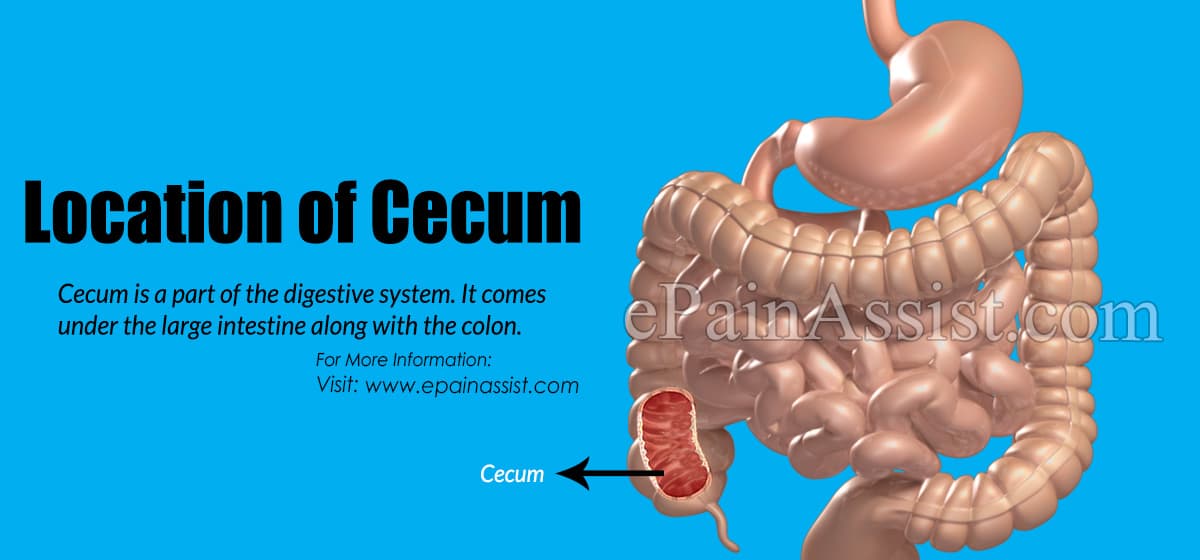Cecum is a part of the digestive system. It comes under the large intestine along with the colon.
Location of Cecum
Basically, the body possesses two types of intestines. The small intestine is attached to the stomach and controls the middle part of the digestion. Whereas the large intestine, also called colon is the final section of the digestive system that continues from the small intestine to the anus of the human. The colon or large intestine is divided into four parts: the ascending, transverse, descending and the sigmoid colon. The ascending colon is the first region of the large intestine which is called cecum.

To be precise, the cecum is the first or initial part of the large intestine that can be found in the suprapubic region and the right iliac fossa. It lies slightly below the ileocaecal junction and if it is enlarged due to feces, gas and malignancy, it can easily be palpated in the right iliac fossa. The cecum is approximately 6 cm in length with a diameter of 9 cm.
Function of Cecum
The main function of the digestive system is to digest the food and absorb nutrients. Generally, digestion is the process to break down the food into small units so that they can be absorbed across the digestive tract. The process of digestion starts from the mouth where the food is ingested and chewed thoroughly to make it a bolus and is thus swallowed to pass it down to the stomach to complete the digestion. Once the food enters the stomach, it begins to breakdown further with the help of the enzymatic digestion. The muscles of the stomach mix the food with secretion which is also known as chyme. The chyme passes into the small intestine; it’s a place where the majority of the digestion and nutrient absorption process occurs. Many nutrients like fats, amino acids, and glucose absorb here. The final stage of the digestive system is the large intestine and cecum. The cecum is a large, muscular sac that collects the ileum expelled undigested food. Being a part of the large intestine, the cecum creates space for liquids that is emptied from the small intestine. As mentioned above, during digestion, small intestine absorbs nutrients from solid foods, and passes the undigested or solid and liquid material to the large intestine so that it is absorbed into the body. Here the cecum behaves as a receptacle for the liquids passed into the large intestine. More than just a liquid receptacle, the cecum is also responsible for the absorption of the salts and electrolyte back into the body. Another important function of the cecum is lubrication and cellulose digestion. In lubrication, cecum lubricates the food that passes to the large intestine. The mucus is the liquid that is used to lubricate the solid waste so it easily passes in the rest parts of the large intestine.
Causes of Cecum Pain
The large intestine consists of five segments, and cecum is the first part of it. The primary function of the large intestine is to absorb salt, water, and minerals from the solid waste. During this process, one may experience pain in the cecum or any other part of the large intestine. Few important causes of cecum pain are listed below:
Crohn’s Disease: This is an inflammatory bowel disease which is caused due to a weak immune system. The disease is found to be associated with watery stool, pain in abdomen, diarrhea, and low appetite. The infection can occur in the patches and affect cecum.
Cecal Volvulus: This is the condition wherein there is an axial rotation of the cecum along with the terminal ileum and certain portion of the ascending colon. In certain cases, the rotation may be upwards instead of axial and is referred to as Cecal Bascule. Hence, both condition results in the blockage and/or strangulation of the large intestine. The symptoms associated with these disorders are abdominal pain, vomiting, severe constipation, nausea and low appetite.
Colorectal Cancer: Although, the main cause of colorectal cancer is not yet known; yet, various disorders of the colon like Crohn’s disease, ulcers may increase the possibility of colorectal cancer. The general symptoms associated with colorectal cancer are bloating, blood in stool, watery stool, low immunity system, low blood pressure, incomplete stool elimination, sudden weight loss, and pain in the cecum and abdomen.
Inflammation in Cecum: Inflammation in cecum can happen due to extremely loose bowels caused because of bacterial infection like Clostridium. Neutropenic enterocolitis, also referred to as typhlitis, is a severe condition caused by intestinal and extreme bacterial disease. It is known to cause cecum pain and is related to lower levels of neutrophil count in the blood. Typhlitis is generally observed to be related to patients who have experienced chemotherapy, AIDS, kidney transplant or elderly individuals who have a feeble immune system.
Whatever the cause of the pain in cecum is, one must not delay is seeing a doctor as early as possible when they notice the symptoms mentioned above. Pain in cecum or abdomen can be for many reasons; however, if it is associated with changes in bowel movement, it is essential to take things seriously and get a proper diagnosis and treatment done.
Lohsiriwat, V. (2015). The cecal anatomy: a review of normal anatomy and great mimickers of cecal pathology. Clinical Anatomy, 28(1), 88-97.
Seitz, U., Böttner, M., Herold, A., & Kreisel, W. (2018). Intestinal obstruction and cecal volvulus: rare primary causes of abdominal pain in a patient with severe hemophilia A. Case Reports in Gastroenterology, 12(3), 568-574.
American Cancer Society. (2021). Colorectal Cancer Risk Factors. https://www.cancer.org/cancer/colon-rectal-cancer/causes-risks-prevention/risk-factors.html
Tung, K. L., Lai, C. W., & Luo, C. C. (2017). Diagnosis of a cecal bascule by emergency physician-performed bedside ultrasonography in the ED. The American Journal of Emergency Medicine, 35(3), 525-e3.
Also Read:
